Learn how to make fish stock with any type of fish. Whether you use white-fleshed fish or go with an oily fish like salmon heads, making your own homemade fish stock is easier than you think. The short cooking time keeps the flavor fresh and light while also offering lots of nourishment. Plus, you can add incredible depth to a simple fish stock recipe by adding basic ingredients like vegetables and white wine to make deeply flavored fish fumet.
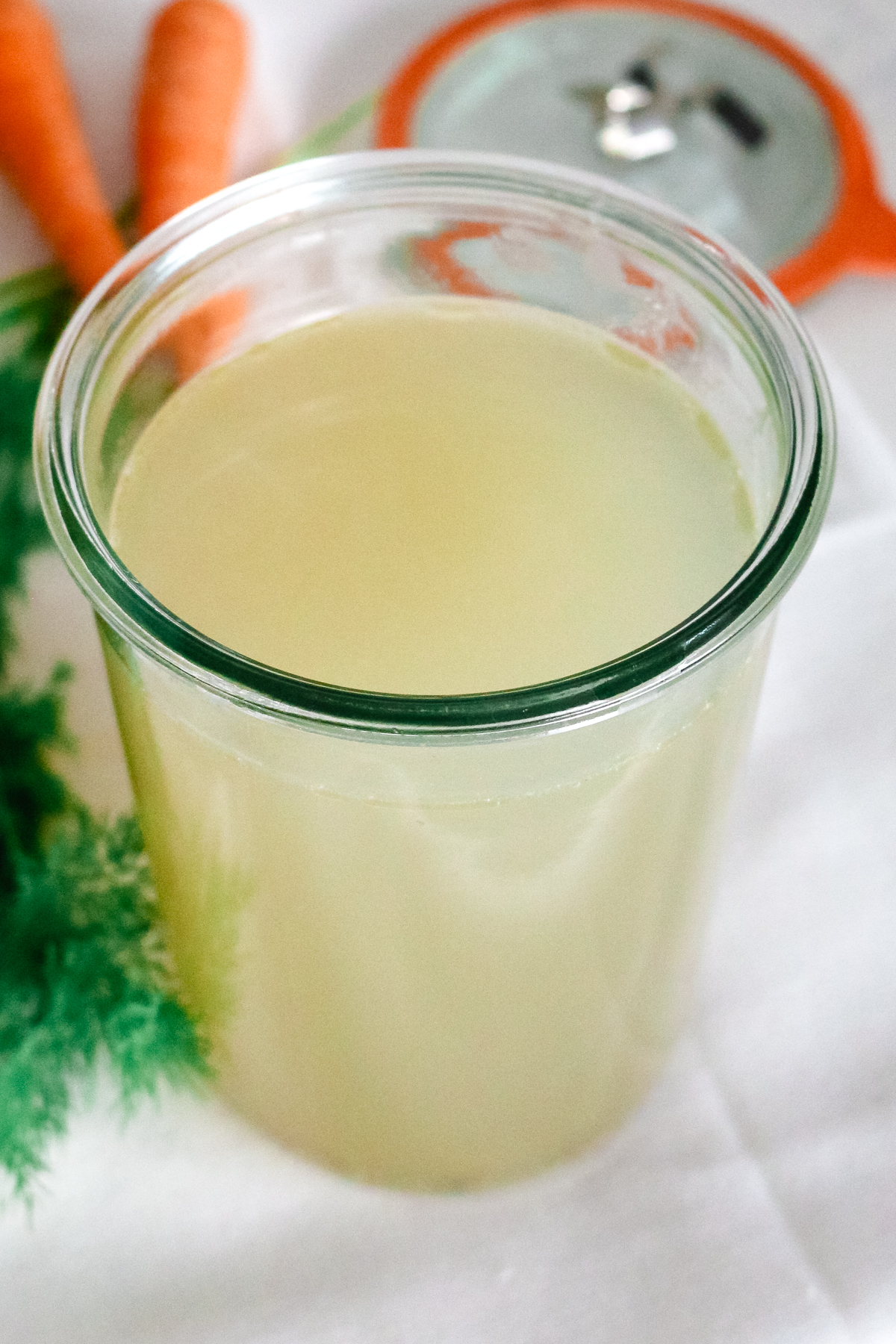
Take the often-overlooked fish discards and transform them into liquid gold in your kitchen. With just a handful of ingredients, you can have a broth that exudes sophistication and elevates any seafood dish it touches. Fumet de poisson (or fish bone broth) is more than just a recipe - it's a celebration of delicate flavors, nutrient-packed simplicity, and sustainability. And it all starts with a simple, yet essential ingredient - various fish scraps including fish head.
Looking for more homemade stock recipes? Check out chicken feet bone broth, easy meat stock, and beef bone broth.
Jump to:
Recipe Overview
- Prep and Cook Time: 30 minutes of cooking time
- Cooking Method: Stove-top
- Dietary Info: Whole 30, WAPF, GAPS, Paleo, Low-Carb - incredibly nutrient-dense food
- Tools Needed: Large pot and a fine-mesh sieve
- Skill Level: Easy
Key Features & Benefits
Inexpensive broth - Fish stock is surprisingly inexpensive to make. Most fish markets will sell their unused fish heads and carcasses for super cheap (sometimes even free - just ask!)
Avoid food waste: Don't let any part of the whole fish go to waste. Make the most of heads, tails, and bones that might otherwise be discarded.
Quick cooking time - The primary cooking method is on the stovetop and requires just 30 minutes of cooking time. Compared to traditionally prepared bone broth, that is just a fraction of the time it takes to make this liquid gold.
Incredibly nutrient-dense food - Fish stock is packed with nutrition from collagen to minerals like iodine.
Versatile serving options - Whether you stop at fish stock or jazz it up for fish fumet, one thing is certain - you have many options to serve it!
Is fish stock good for you?
According to a South American proverb, fish broth will cure anything. Traditionally, the butcher and fishmonger have always sold the meat and fish on the bone. It wasn't until recently that Americans began preferring their meat and fish de-boned and filleted. Sure, it's convenient, but it lacks the nutrition that cooking with whole animals might offer.
When you cook the entire fish, you produce collagen from the cartilage that can only be found in bones and heads. Collagen is a protein made up of amino acids responsible for healthy hair, skin, and nails, and it's also used to restore elasticity to the joints, making it a perfect supplement for those suffering from arthritis, according to a PubMed journal.
There are more health benefits to collagen beyond the scope of this post, but it's no surprise that fish broth has tremendous capabilities to heal.
Additionally, making stock with fish heads also produces a very iodine-rich broth that is healing to the thyroid. The thyroid gland of the fish is in the head, but it disintegrates so much during cooking that you won't even taste it. Instead, it's infused into the broth, making it an iodine-rich food.
Ingredients for Fish Stock
Learn how to make fish stock with 4 simple ingredients. This easy recipe doesn't take a long time to make and you just need a large stock pot and a fine mesh strainer.
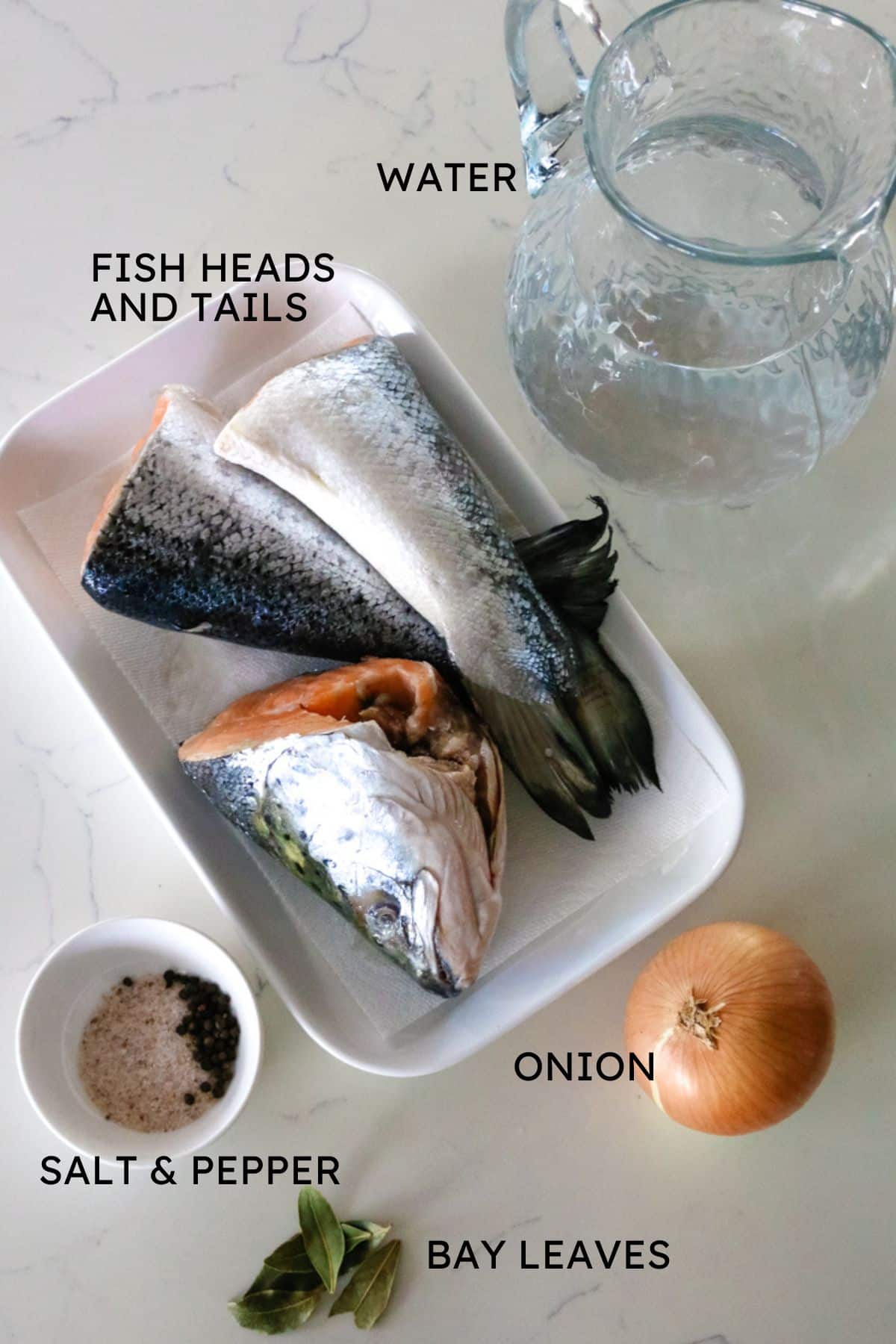
- Fish heads & tails: Your local fish market or a well-stocked seafood section at your local grocery store should carry fish heads, tails, fish skin, and carcass. Ask your local fishmonger if they can provide these specific parts for you. Wild-caught fish is always best and will yield the most nutrition in your fish fumet. But admittedly, I have a hard time sourcing wild-caught heads and tails.
- Onion: Stick to yellow or white onion to keep the flavors mild and the broth light in color.
- Seasonings: A simple blend of sea salt, black peppercorns, and a bay leaf or two is sufficient to give additional flavor without overpowering.
See the recipe card for exact quantities.
Substitutions and Variations
- Spicy - Add chili pepper flakes while cooking to incorporate heat into the stock.
- Vegetable scraps - Feel free to include any aromatic vegetables like carrots, onion peels, celery, or leeks to add more flavor.
- Herb infusion - Add fresh dill or fresh parsley stalks (not the herb part) to the broth during the last 10 minutes of cooking time to give it refreshing flavor. You can also garnish the broth with fresh herbs for a vibrant pop of color.
- Fish fumet - Add a cup of dry white wine to the fish stock recipe to make it delicate fumet.
💭Make it Nutrient-Dense: Use wild-caught fish for maximum nutrition from omega-3 fatty acids, vitamins, and minerals. Wild-caught seafood has a higher nutritional profile than farm raised.
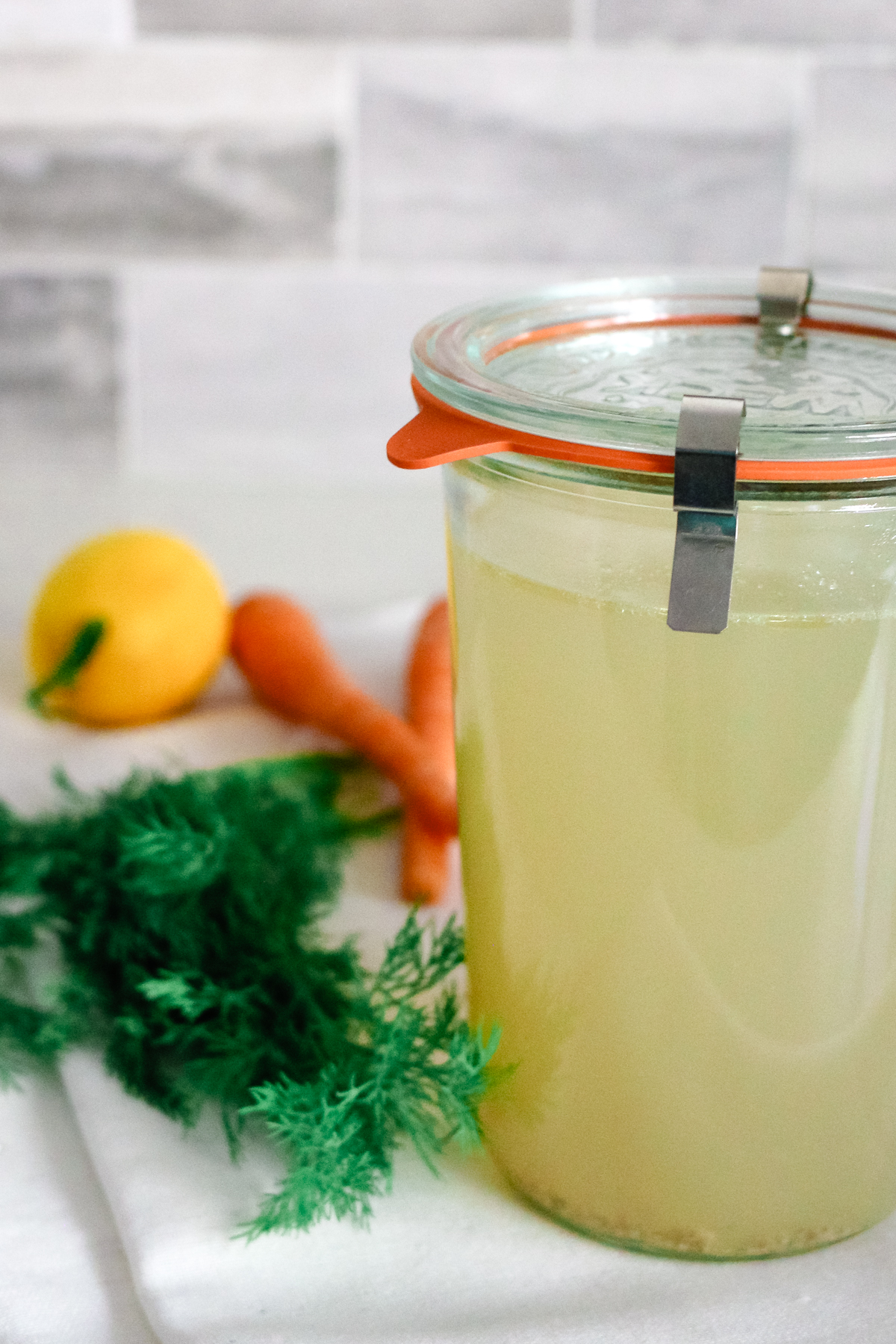
How to Make Fish Stock
The complete printable recipe is below in the recipe card for your convenience. Follow these simple step-by-step instructions for the best results.
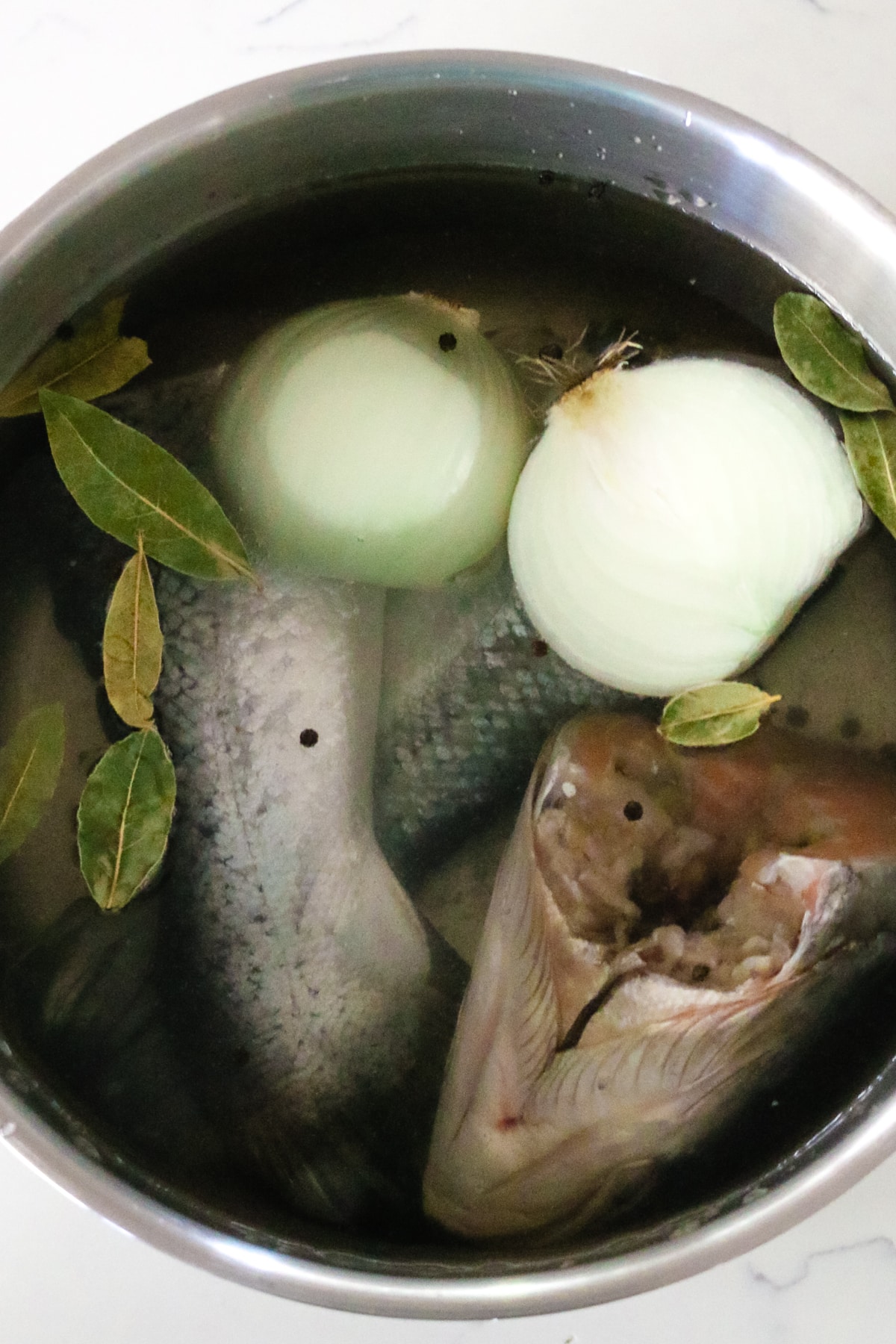
Step 1. Fill
Place well-washed fish heads, tails, and bones into a large stockpot. Add bay leaves, peppercorns, salt, and vegetables if using, and fill with enough cold water to cover all the ingredients. If using wine, add it to the pot.
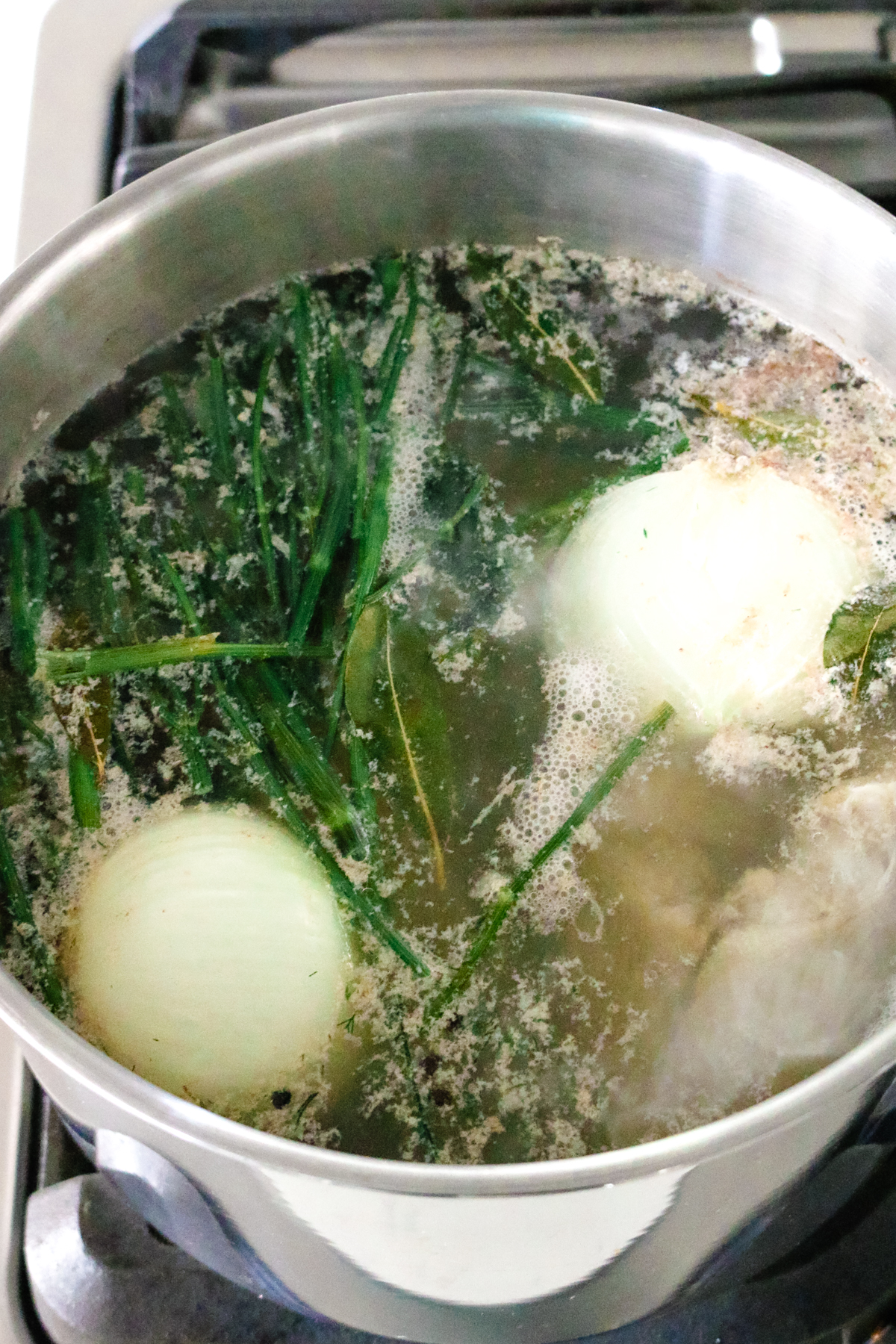
Step 2. Simmer
Bring to a gentle simmer, then lower the heat so that it barely simmers with an occasional bubble. Skim off any scum that accumulates on the surface and continue to gently simmer. Add fresh dill or parsley.
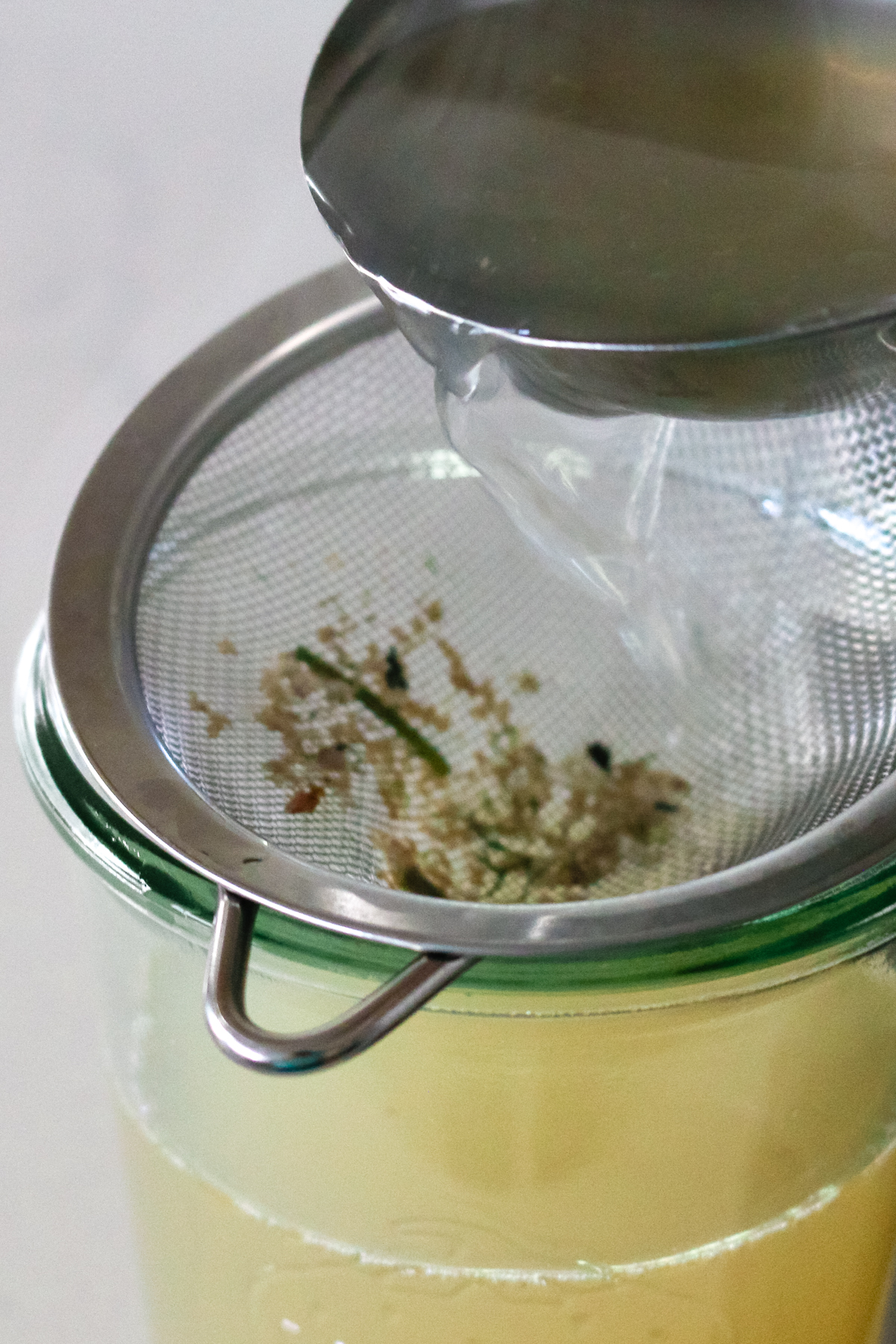
Step 3. Strain
Using a fine mesh sieve or strainer, strain the fish stock into a clean glass jar. Chill and store in the refrigerator.
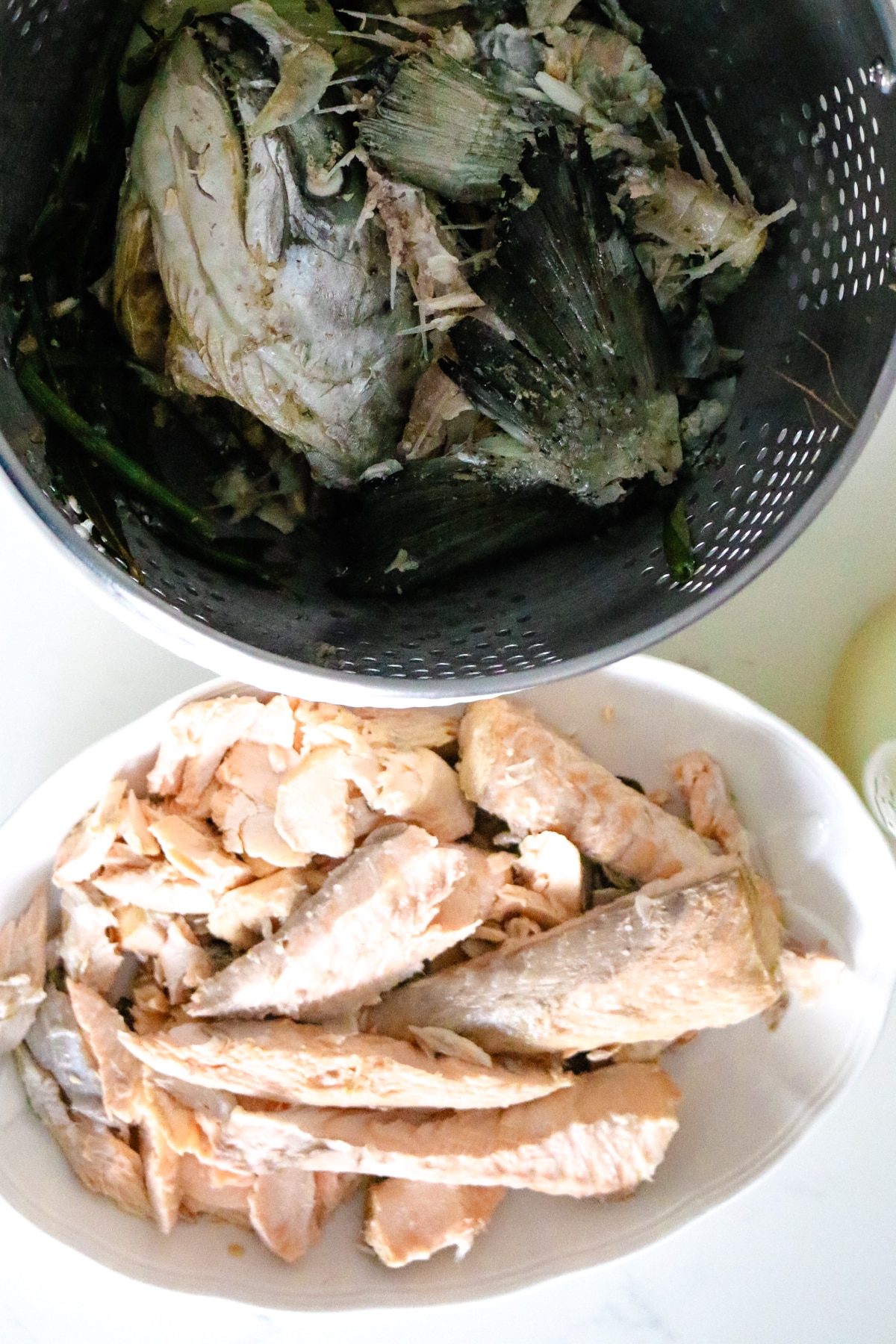
Step 4. Separate
When the fish heads and tails are cool enough to handle, pick off the fleshy parts of the fish to use in recipes. Discard the carcass.
Helpful Tips for Fish Fumet
Start with clean fish - Rinse the fish heads and tails very well under cold running water to remove any slime, blood, or debris. This will help prevent an off-flavor or bitter taste and yield a cleaner broth.
Remove gills - For more clarified fish fumet, remove fish gills that are on the side of the fish heads.
Keep it on low heat - Don't let your fish stock boil or vigorously simmer as that may produce more scum and result in a cloudy broth.
Know your fish - For a lighter fish stock, use white-fleshed fish such as red snapper or bass. If you want a heavier stock with a higher fat content, salmon heads and tails are a great option.
Hit it with citrus and herbs - Finish it with a squeeze of fresh lemon juice or top it with fresh herbs for maximum flavor. Learn how to store fresh dill and how to chop fresh dill to maximize this herb. You can also sprinkle a few pinches of dried parsley substitute into your fish stock.
💭Meal Prep Suggestion: Pick out the flesh (meaty part) from the fish heads and tails once done cooking. Add that back to the stock or fumet to add some meaty heartiness.
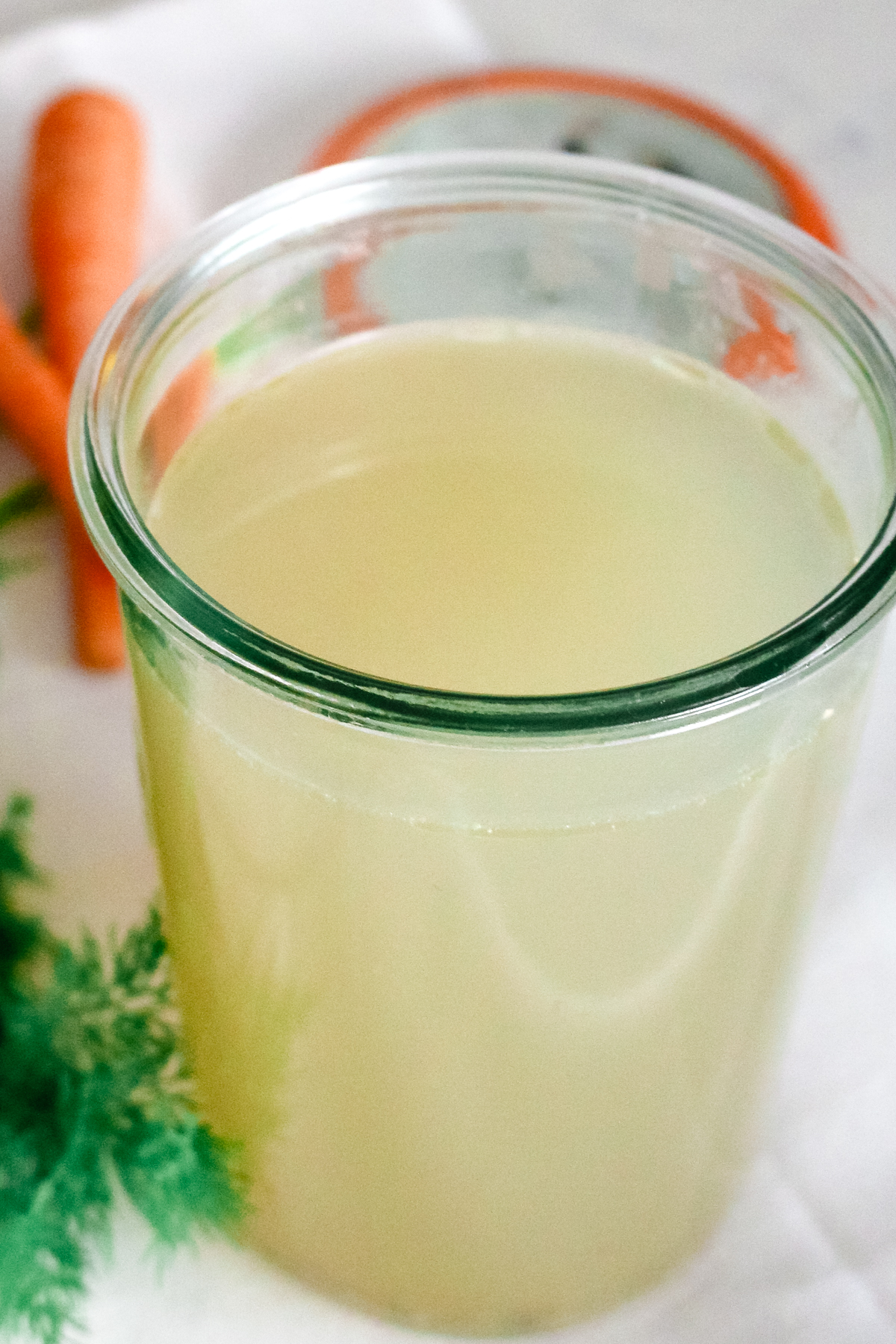
Serving Suggestions
I use this easy fish stock recipe with any seafood-based soup like this fish soup recipe. It also makes a great base in seafood dishes like risotto, paella, and much more. You can also use it as a base for fish velouté or fish sauce. If you make the seafood stock with an oilier fish like salmon, you can use that salmon stock for chowder and other hearty soups where the fat content will add a satisfying depth.
More fish stock pairing suggestions:
Storage and Reheating Instructions
How long does fish stock last in the refrigerator?
To store: Store fish fumet in airtight containers like glass jars in the fridge for up to 3 days.
Storage containers: These wide-mouth mason jars are great for storing broth and stocks but these Weck preserving jars are too cute to pass up.
To freeze: For longer storage and future use, freeze fish fumet in glass jars, leaving plenty of headspace at the top for water expansion. Freeze for up to 3 months. Thaw overnight in the fridge before adding to recipes.
To reheat: Gently heat on the stovetop or add directly to your recipe chilled.
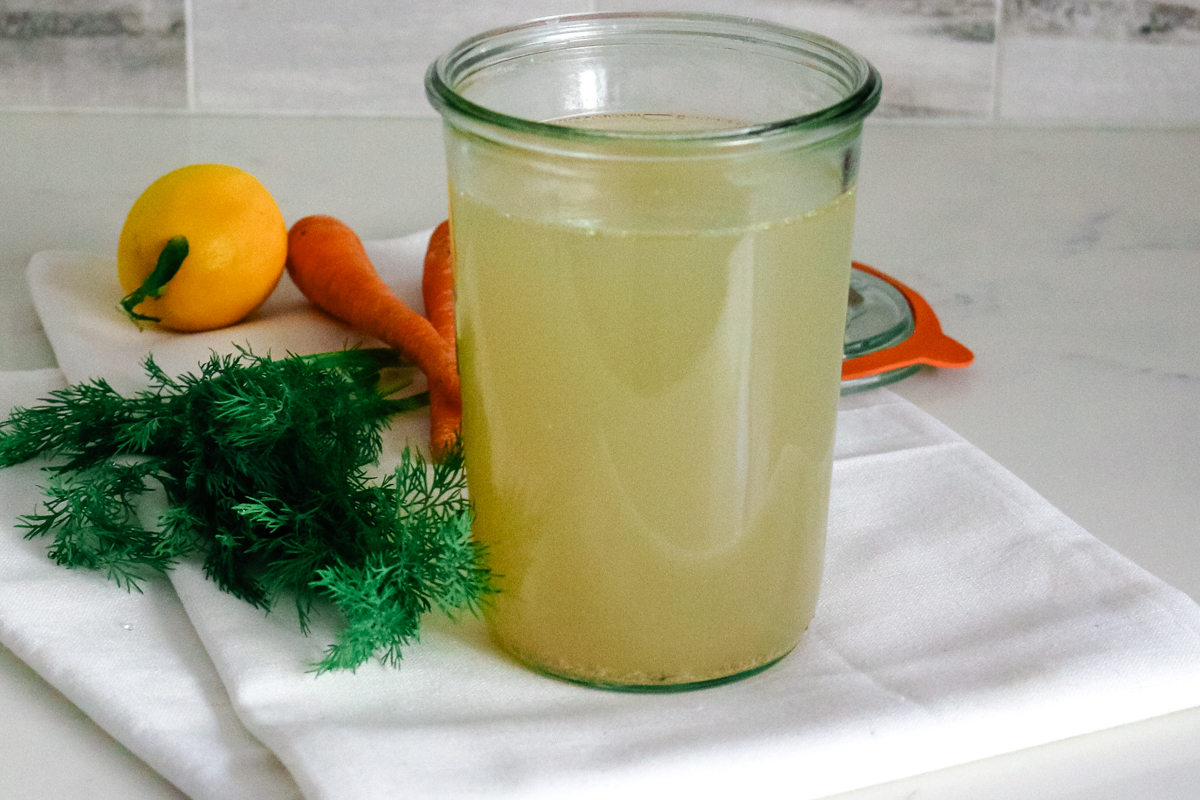
Frequently Asked Questions
Fish stock and fish fumet both start with fish bones, but they differ in their ingredients and purpose. Fish stock typically includes various vegetables like onions, carrots, and celery, creating a heartier base for various dishes. On the other hand, fish fumet is a lighter broth, focusing primarily on fish bones, heads, and tails, often with the addition of white wine for a more delicate flavor. While fish stock is versatile and suitable for a wide range of recipes, fish fumet is prized for its clarity and subtlety, ideal for delicate seafood-based dishes.
It's best to start with thawed fish as it has to be rinsed well under cold running water. Thawing ensures that the fish can be thoroughly cleaned and guarantees a fresh base for your fish stock. If the fish is sealed, you can do a quick thaw by submerging it in a bowl of room temperature water. Replace the water every 30 minutes until the fish has thawed. Rinse to remove any residual ice crystals.
This depends on the flavor profile you are aiming for. For a lighter stock, use the trimmings of a variety of white fish like snapper, cod, or halibut. If you desire a richer and more flavorful fish stock, opt for oilier fish like salmon or mackerel, as they contribute a depth of flavor and higher fat content. Ultimately, this is a matter of preference and the purpose of your stock.
While technically, you can use this fish stock recipe and make it in your pressure cooker, I advise against it to better control the temperature and simmering process. You want to avoid the fish stock from boiling vigorously, which will likely happen in a pressure cooker.
Looking for more related recipes? Here are some ideas:
Did you make this fish fumet recipe? Please leave a ⭐ recipe rating in the recipe card below and leave a review in the comments. Thank you!💚
Printable Recipe

Traditional Fish Stock Recipe (Fish Fumet)
Equipment
Ingredients
- 4 pounds bones, heads, and tails of fish
- 4 bay leaves
- 1 tablespoon whole peppercorns
- 1 tablespoon sea salt
- 4 vegetable scraps like onions, carrots, celery optional
- 4 quarts filtered water
- 1 cup dry white wine optional for fish fumet
- 3 sprigs fresh dill or parsley
Instructions
- Fill: Place well-washed fish heads, tails, and bones into a large stockpot. Add bay leaves, peppercorns, salt, and vegetables if using and fill with enough water to cover all the ingredients. If using wine, add it to the pot.
- Simmer: Bring to a gentle simmer, then lower the heat so that it barely simmers with an occasional bubble. Skim off any scum that accumulates on the surface and continue to gently simmer. Add fresh dill or parsley.
- Strain: Using a fine mesh sieve or strainer, strain the fish stock into a clean glass jar. Chill and store in the refrigerator.
- Separate: When the fish heads and tails are cool enough to handle, pick off the fleshy parts of the fish to use in recipes. Discard the carcass.
Notes
- Start with clean fish - Rinse the fish heads and tails very well under cold running water to remove any slime, blood, or debris. This will help prevent an off-flavor or bitter taste and yield a cleaner broth.
- Remove gills - For more clarified fish fumet, remove fish gills that are on the side of the fish heads.
- Keep it on low heat - Don't let your fish stock boil or vigorously simmer as that may produce more scum and result in a cloudy broth.
- Know your fish - For a lighter fish stock, use white-fleshed fish such as red snapper or bass. If you want a heavier stock with a higher fat content, salmon heads and tails are a great option.


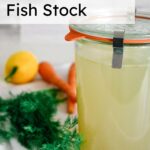



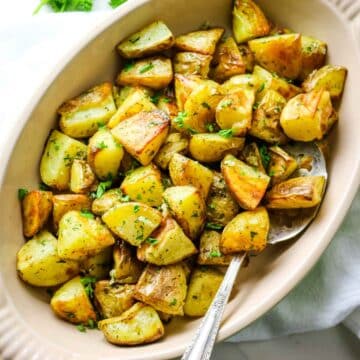
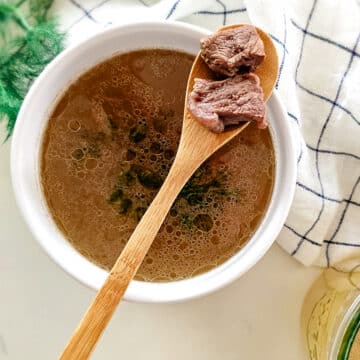



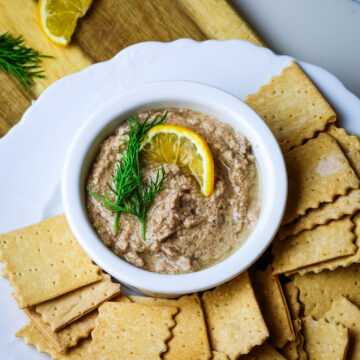



Terrapin says
Any opinion on whether to remove scales or leave them on ?
I filleted some speckled trout, and have skins with scales on, along with the heads and bones. All ok in the stock ? Or would it be better to remove the scales first ?
thanks
Anya says
I would remove the scales. Heads and bones are more than okay in the fish stock. In fact, that's what will give you the gelatinous, most nutrient dense stock. But scales need to go. 🙂
joshua shemeta says
i ate the eyeball 🙂
thanks for the recipe and info - i been loving bones lately for the collagen n mineral content - my friends started fishing lately so i'll probably have a regular flow of bones to cook with. later i'll be joining them so that is A W E S O M E. cheers!
Anya says
The collagen and minerals in fish broth are remarkable! So glad you can enjoy it!
joshua shemeta says
i ate the eyeball 🙂
thanks for the post, i will be learning to fish soon (finally!), and recently my friends started fishing so bones are starting to become a regular ingredient. very lovely
Anya says
Haha! So happy to hear that. Enjoy!
Leticia says
Hi, what do you do with the meat that you "fish" out? Is it good to eat or prepare other dishes? Or it just goes to the bin?
Anya says
Hi Leticia,
That meat is good to eat and you can use that in fish soups and other recipes. 🙂
Kevin says
I'm a bit late on this topic, but a Chinese herbal medicine guy says put in a kiwi fruit as it helps to disolve the bones and collagen. This is what plan to do. Thanks for your article which has encouraged me to try this. Greetings from Australia